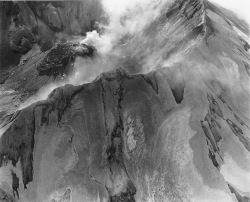Frank Gohlke [ born in 1942] has been a leading figure in American landscape photography
for over thirty years. He has photographed grain silos in Minnesota,
the aftermath of a tornado in Texas, the destruction and rebirth of the
land after the Mount St. Helens eruption in Washington, and a rivers
quiet course in Massachusetts. His is a career of deep, unbroken
contemplation of the enduring landscape and of our place within it. And
for nearly as long as Gohlke has been photographing the landscape, he
has been writing about it. In the spirit of Henri Cartier-Bresson's
seminal book, "The Minds Eye", and Robert Adams's "Beauty in
Photography", Gohlkes writings on photography span from the
philosophical to the personal.
In interviews, essays, artist statements,
and lectures, Gohlke focuses both on his own work and life, and on the
works and lives of the photographers around him. Woven throughout is his
affection for and loyalty to the landscape around him, and his uncanny
ability to convey the richness of his experience to readers-in words
just as in images.
He has been awarded two Guggenheim Fellowships and two fellowships from the National Endowment for the Arts. Known for his large format landscape photographs, Gohlke's work has been shown at museums all over the world.
“Photographs are rather cool things on a wall. They don’t reach out and insist that you look at them like a big painting or a piece of sculpture would. And then of all the people who do look, how many really look? And of those who really look, how many see? Speaking very personally, I am delighted when anyone, anyone seems to have looked carefully enough at a photograph of mine to have some sense of what it’s about. And it doesn’t take much in the way of verbal response to get a sense of whether someone has really understood something. And every time that happens I’m just incredibly grateful. It just seems like more than I had any right to expect. I guess in a way you prepare yourself for the disappointment, the inevitable disappointment of doing all this work, putting all these things in front of people and they being sort of blank. You prepare yourself for that. And so when anyone seems as though they’ve really seen and understood something, it just feels like an incredible gift.”
“Photographs are rather cool things on a wall. They don’t reach out and insist that you look at them like a big painting or a piece of sculpture would. And then of all the people who do look, how many really look? And of those who really look, how many see? Speaking very personally, I am delighted when anyone, anyone seems to have looked carefully enough at a photograph of mine to have some sense of what it’s about. And it doesn’t take much in the way of verbal response to get a sense of whether someone has really understood something. And every time that happens I’m just incredibly grateful. It just seems like more than I had any right to expect. I guess in a way you prepare yourself for the disappointment, the inevitable disappointment of doing all this work, putting all these things in front of people and they being sort of blank. You prepare yourself for that. And so when anyone seems as though they’ve really seen and understood something, it just feels like an incredible gift.”
| Frank Gohlke |
A Woman watering her garden, near Kirkville, Mississippi, 1986
Grain Elevator and Lightning Flash, Lamesa, Texas, 1975
http://www.cartermuseum.org/exhibitions/accommodating-nature-the-photographs-of-frank-gohlke/artworks/363
Chemical Brook enters the Sudbury River, Ashland, Massachusetts, December 1991
http://eyelevel.si.edu/2009/02/frank-gohlkes-world-in-black-and-white-and-sometimes-color.html
Irrigation Canal, Albuquerque, N.M., 1974
http://horsesthink.com/?p=3728
The Sudbury River-Ashland, Massachusetts, October, 1989
http://www.bu.edu/prc/MPP/gohlke.htm
http://www.gundfdn.org/news-and-publications/annual-reports/photography-portfolios/1997-lake-erie
http://artweek.la/issue/april-23-2012/article/frank-gohlke-mount-st-helens
The Sudbury River, Hopkinton, MA, November 1990
http://www.terrain.org/interview/28/














No comments:
Post a Comment